warning lights FIAT PALIO 2003 178 / 1.G India Version Owners Manual
[x] Cancel search | Manufacturer: FIAT, Model Year: 2003, Model line: PALIO, Model: FIAT PALIO 2003 178 / 1.GPages: 156, PDF Size: 6.27 MB
Page 9 of 156
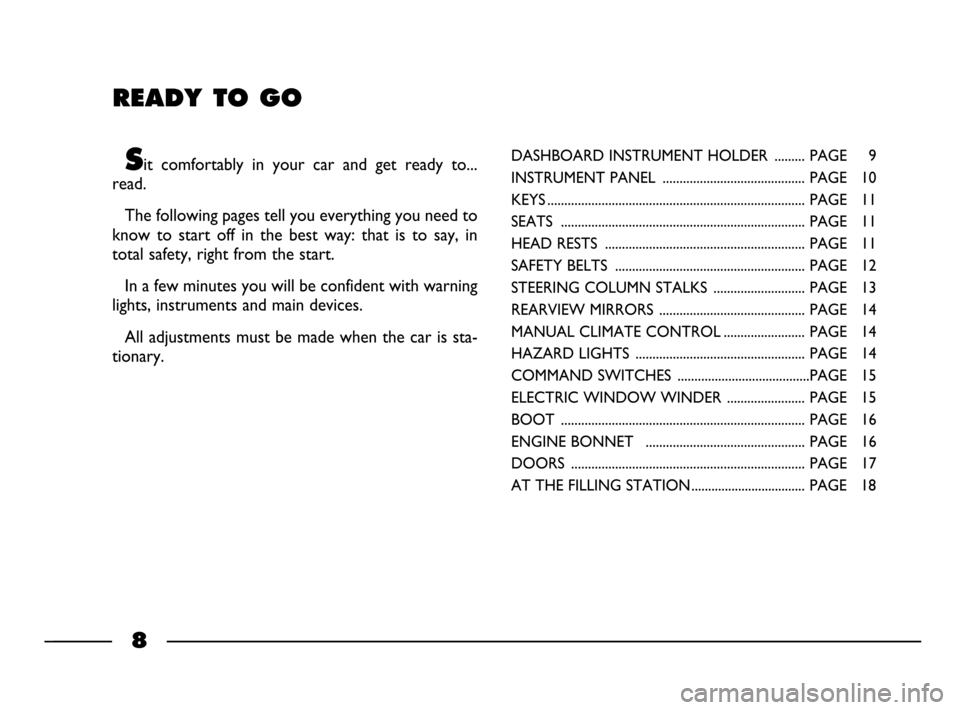
READY TO GO
Sit comfortably in your car and get ready to...
read.
The following pages tell you everything you need to
know to start off in the best way: that is to say, in
total safety, right from the start.
In a few minutes you will be confident with warning
lights, instruments and main devices.
All adjustments must be made when the car is sta-
tionary.DASHBOARD INSTRUMENT HOLDER ......... PAGE 9
INSTRUMENT PANEL .......................................... PAGE 10
KEYS ............................................................................ PAGE 11
SEATS ........................................................................ PAGE 11
HEAD RESTS ........................................................... PAGE 11
SAFETY BELTS ........................................................ PAGE 12
STEERING COLUMN STALKS ........................... PAGE 13
REARVIEW MIRRORS ........................................... PAGE 14
MANUAL CLIMATE CONTROL ........................ PAGE 14
HAZARD LIGHTS .................................................. PAGE 14
COMMAND SWITCHES .......................................PAGE 15
ELECTRIC WINDOW WINDER ....................... PAGE 15
BOOT ........................................................................ PAGE 16
ENGINE BONNET ............................................... PAGE 16
DOORS ..................................................................... PAGE 17
AT THE FILLING STATION .................................. PAGE 18
8
1-19 03/03/2003 05:44 PM Page 8
Page 21 of 156
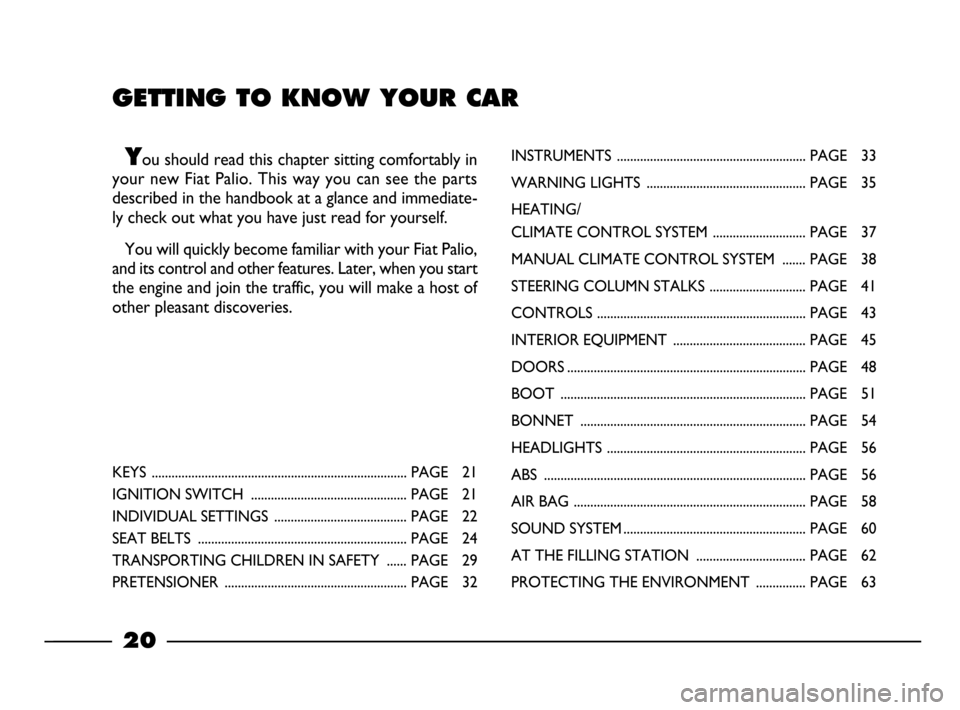
GETTING TO KNOW YOUR CAR
You should read this chapter sitting comfortably in
your new Fiat Palio. This way you can see the parts
described in the handbook at a glance and immediate-
ly check out what you have just read for yourself.
You will quickly become familiar with your Fiat Palio,
and its control and other features. Later, when you start
the engine and join the traffic, you will make a host of
other pleasant discoveries.INSTRUMENTS ......................................................... PAGE 33
WARNING LIGHTS ................................................ PAGE 35
HEATING/
CLIMATE CONTROL SYSTEM ............................ PAGE 37
MANUAL CLIMATE CONTROL SYSTEM ....... PAGE 38
STEERING COLUMN STALKS ............................. PAGE 41
CONTROLS ............................................................... PAGE 43
INTERIOR EQUIPMENT ........................................ PAGE 45
DOORS ........................................................................ PAGE 48
BOOT .......................................................................... PAGE 51
BONNET .................................................................... PAGE 54
HEADLIGHTS ............................................................ PAGE 56
ABS ............................................................................... PAGE 56
AIR BAG ...................................................................... PAGE 58
SOUND SYSTEM ....................................................... PAGE 60
AT THE FILLING STATION ................................. PAGE 62
PROTECTING THE ENVIRONMENT ............... PAGE 63
20
KEYS ............................................................................. PAGE 21
IGNITION SWITCH ............................................... PAGE 21
INDIVIDUAL SETTINGS ........................................ PAGE 22
SEAT BELTS ............................................................... PAGE 24
TRANSPORTING CHILDREN IN SAFETY ...... PAGE 29
PRETENSIONER ....................................................... PAGE 32
20-63 03/03/2003 06:02 PM Page 20
Page 36 of 156

35
WARNING
LIGHTS
The warning lights come on in the
following circumstances:
BATTERY NOT
CHARGING PROPER-
LY (red)
When there is
a fault in the current gen-
erating system.
Go to a
Fiat Dealershipand pre-
vent deploying the battery.
When the key is turned to
MAR the
light comes on but should go out the
moment the engine is started.
LOW ENGINE OIL
PRESSURE (red)
When
the engine oil pressure
drops under the normal
value.
When the key is turned to
MARthe
light comes on but should go out the
moment the engine is started.
A delay in the light going out is ac-
ceptable only when the engine is idling.
If the engine has been heavily taxed,
the light may flash when the engine re-
turns to idle. The light should howev-
er go out when you accelerate slight-
ly.
v
w
If the vwarning light
comes on while the car is
moving, stop the engine
immediately and contact a Fiat
Dealership.
INJECTION SYSTEM
FAILURE (red) (petrol
version)
When there is a
fault in the injection system.
When the ignition key is turned to
the
MAR position, the light comes on
but should go out after a few seconds.
The warning light will stay on or
come on when travelling to indicate
imperfect operation of the injection
system with possible loss of perfor-
mance, poor handling and higher con-
sumption.
g
In these conditions, you can contin-
ue driving but you should avoid de-
manding efforts from the engine or
high speeds. Contact a
Fiat Dealer-
ship
as soon as possible.
Using the car for long periods when
the warning light is on may cause dam-
age especially when the engine is run-
ning irregularly or misfiring. The car
should only be used for short periods
at low speeds.
Occasional and brief lighting of the
warning light is meaningless.
HANDBRAKE EN-
GAGED / LOW
BRAKE FLUID (red)
In
two cases:
1.When the handbrake is applied.
2. when the brake fluid level falls be-
low the minimum level.
x
20-63 03/03/2003 06:02 PM Page 35
Page 37 of 156
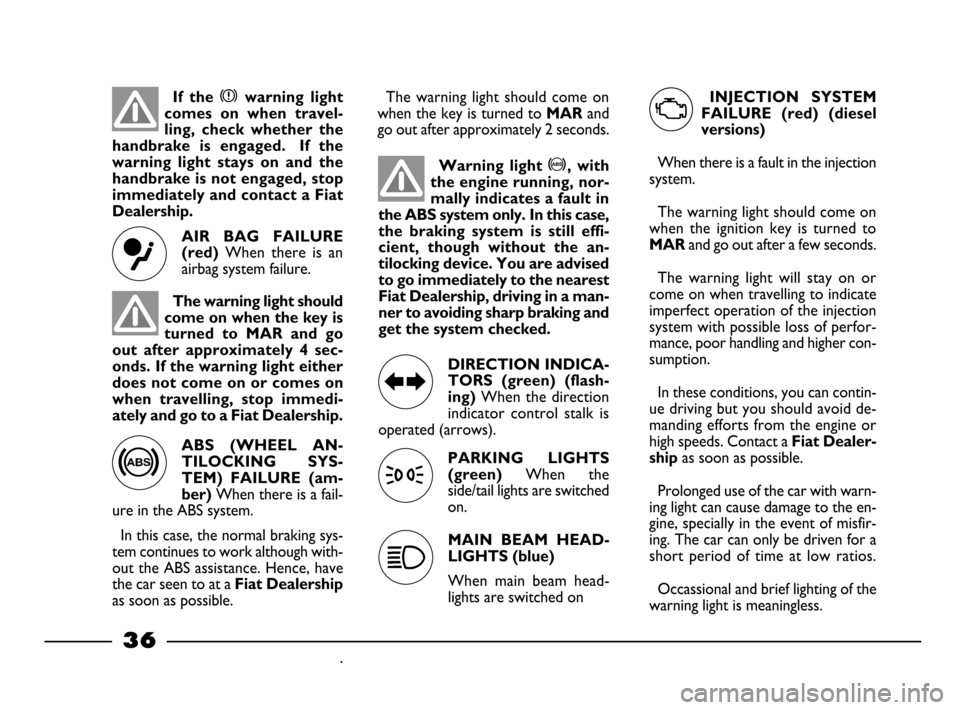
ABS (WHEEL AN-
TILOCKING SYS-
TEM) FAILURE (am-
ber)
When there is a fail-
ure in the ABS system.
In this case, the normal braking sys-
tem continues to work although with-
out the ABS assistance. Hence, have
the car seen to at a
Fiat Dealership
as soon as possible.
The warning light should come on
when the key is turned to
MARand
go out after approximately 2 seconds.
DIRECTION INDICA-
TORS (green) (flash-
ing)
When the direction
indicator control stalk is
operated (arrows).
PARKING LIGHTS
(green)
When the
side/tail lights are switched
on.
RE
3
MAIN BEAM HEAD-
LIGHTS (blue)
When main beam head-
lights are switched on
1
AIR BAG FAILURE
(red)
When there is an
airbag system failure.
If the xwarning light
comes on when travel-
ling, check whether the
handbrake is engaged. If the
warning light stays on and the
handbrake is not engaged, stop
immediately and contact a Fiat
Dealership.
>
Warning light >, with
the engine running, nor-
mally indicates a fault in
the ABS system only. In this case,
the braking system is still effi-
cient, though without the an-
tilocking device. You are advised
to go immediately to the nearest
Fiat Dealership, driving in a man-
ner to avoiding sharp braking and
get the system checked.
û
The warning light should
come on when the key is
turned to MAR and go
out after approximately 4 sec-
onds. If the warning light either
does not come on or comes on
when travelling, stop immedi-
ately and go to a Fiat Dealership.
The warning light should come on
when the key is turned to
MARand
go out after approximately 2 seconds.
36
INJECTION SYSTEM
FAILURE (red) (diesel
versions)
When there is a fault in the injection
system.
The warning light should come on
when the ignition key is turned to
MARand go out after a few seconds.
The warning light will stay on or
come on when travelling to indicate
imperfect operation of the injection
system with possible loss of perfor-
mance, poor handling and higher con-
sumption.
In these conditions, you can contin-
ue driving but you should avoid de-
manding efforts from the engine or
high speeds. Contact a
Fiat Dealer-
ship
as soon as possible.
Prolonged use of the car with warn-
ing light can cause damage to the en-
gine, specially in the event of misfir-
ing. The car can only be driven for a
short period of time at low ratios.
Occassional and brief lighting of the
warning light is meaningless.
20-63 03/03/2003 06:02 PM Page 36
Page 43 of 156
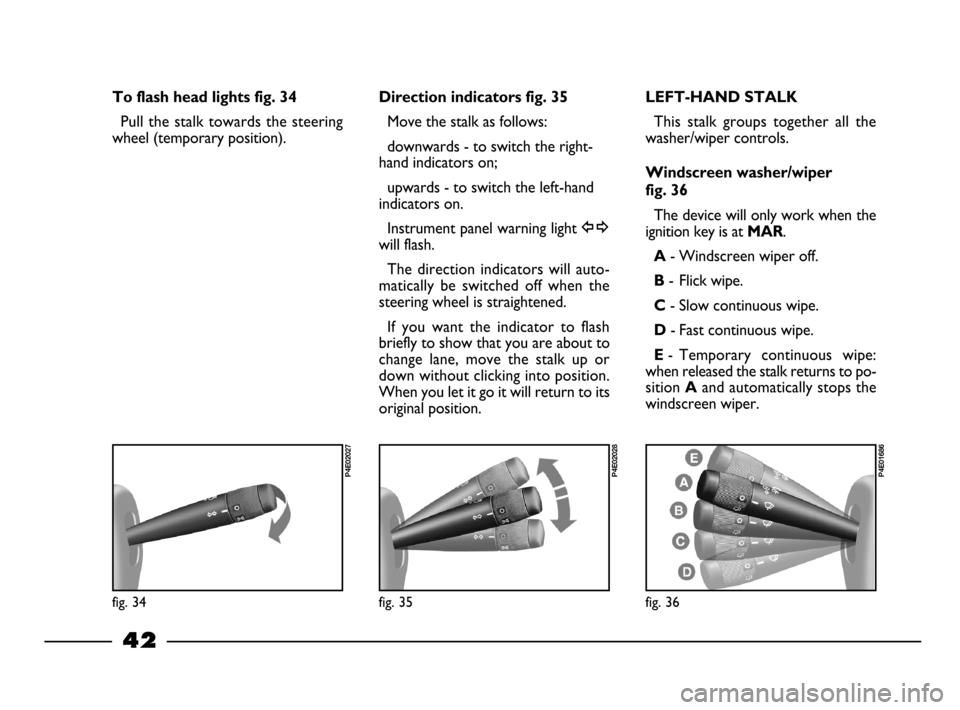
42
fig. 36
P4E01686
To flash head lights fig. 34
Pull the stalk towards the steering
wheel (temporary position).
Direction indicators fig. 35
Move the stalk as follows:
downwards - to switch the right-
hand indicators on;
upwards - to switch the left-hand
indicators on.
Instrument panel warning light
y
will flash.
The direction indicators will auto-
matically be switched off when the
steering wheel is straightened.
If you want the indicator to flash
briefly to show that you are about to
change lane, move the stalk up or
down without clicking into position.
When you let it go it will return to its
original position.
LEFT-HAND STALK
This stalk groups together all the
washer/wiper controls.
Windscreen washer/wiper
fig. 36
The device will only work when the
ignition key is at
MAR.
A- Windscreen wiper off.
B- Flick wipe.
C- Slow continuous wipe.
D- Fast continuous wipe.
E- Temporary continuous wipe:
when released the stalk returns to po-
sition
Aand automatically stops the
windscreen wiper.
fig. 35
P4E02028
fig. 34
P4E02027
20-63 03/03/2003 06:02 PM Page 42
Page 47 of 156
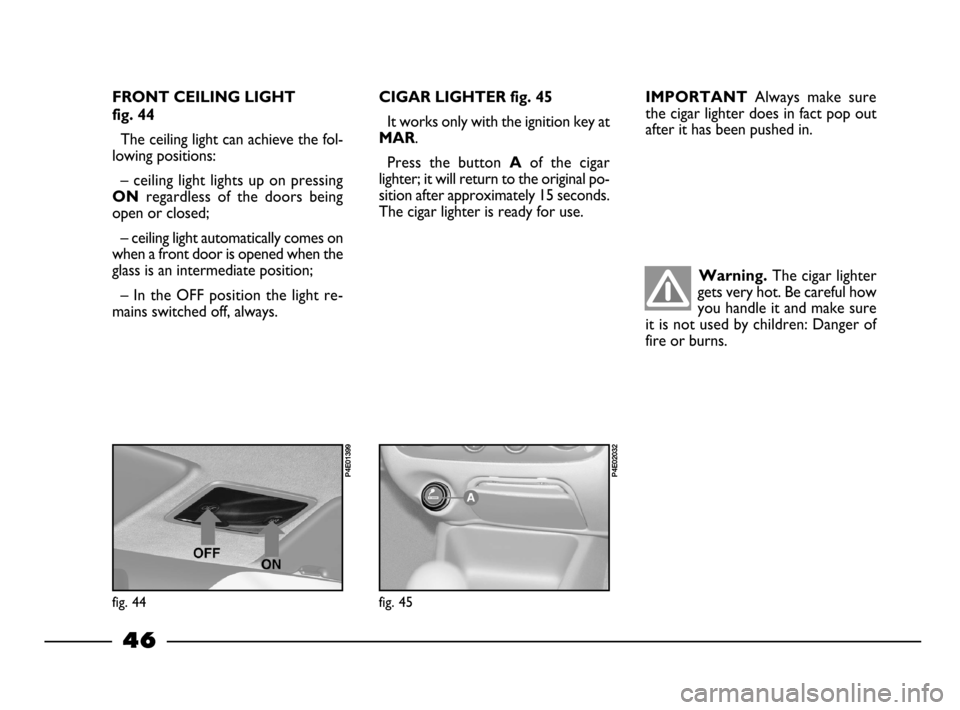
Warning. The cigar lighter
gets very hot. Be careful how
you handle it and make sure
it is not used by children: Danger of
fire or burns.
46
CIGAR LIGHTER fig. 45
It works only with the ignition key at
MAR.
Press the button
Aof the cigar
lighter; it will return to the original po-
sition after approximately 15 seconds.
The cigar lighter is ready for use.
fig. 45
P4E02032
fig. 44
P4E01399
FRONT CEILING LIGHT
fig. 44
The ceiling light can achieve the fol-
lowing positions:
– ceiling light lights up on pressing
ONregardless of the doors being
open or closed;
– ceiling light automatically comes on
when a front door is opened when the
glass is an intermediate position;
– In the OFF position the light re-
mains switched off, always.
IMPORTANT Always make sure
the cigar lighter does in fact pop out
after it has been pushed in.
20-63 03/03/2003 06:03 PM Page 46
Page 70 of 156
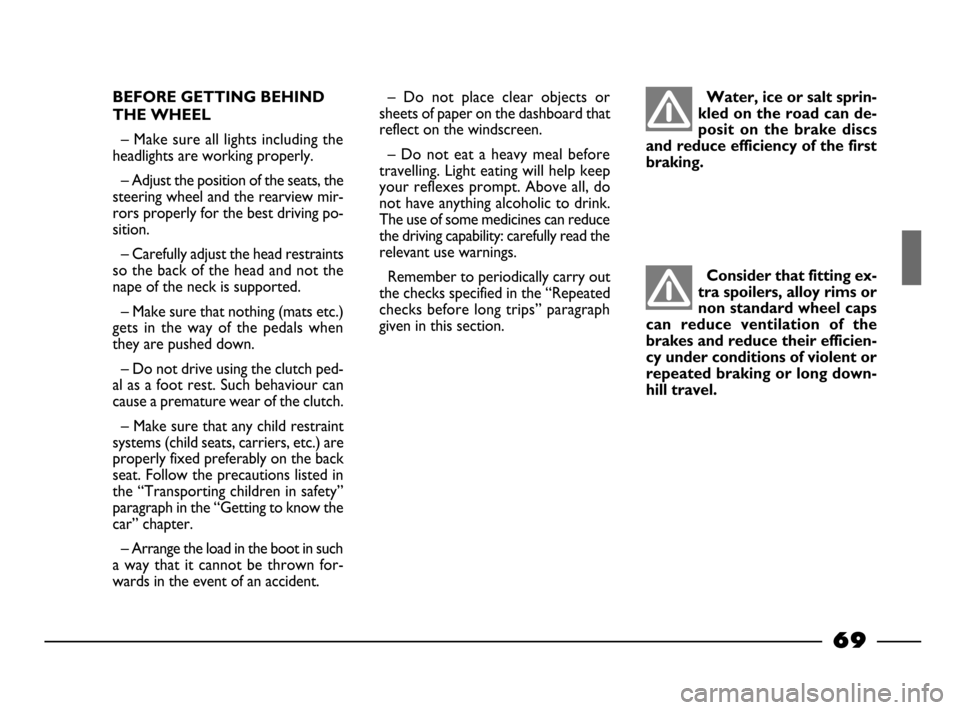
69
Water, ice or salt sprin-
kled on the road can de-
posit on the brake discs
and reduce efficiency of the first
braking.
Consider that fitting ex-
tra spoilers, alloy rims or
non standard wheel caps
can reduce ventilation of the
brakes and reduce their efficien-
cy under conditions of violent or
repeated braking or long down-
hill travel.
BEFORE GETTING BEHIND
THE WHEEL
– Make sure all lights including the
headlights are working properly.
– Adjust the position of the seats, the
steering wheel and the rearview mir-
rors properly for the best driving po-
sition.
– Carefully adjust the head restraints
so the back of the head and not the
nape of the neck is supported.
– Make sure that nothing (mats etc.)
gets in the way of the pedals when
they are pushed down.
– Do not drive using the clutch ped-
al as a foot rest. Such behaviour can
cause a premature wear of the clutch.
– Make sure that any child restraint
systems (child seats, carriers, etc.) are
properly fixed preferably on the back
seat. Follow the precautions listed in
the “Transporting children in safety”
paragraph in the “Getting to know the
car” chapter.
– Arrange the load in the boot in such
a way that it cannot be thrown for-
wards in the event of an accident.– Do not place clear objects or
sheets of paper on the dashboard that
reflect on the windscreen.
– Do not eat a heavy meal before
travelling. Light eating will help keep
your reflexes prompt. Above all, do
not have anything alcoholic to drink.
The use of some medicines can reduce
the driving capability: carefully read the
relevant use warnings.
Remember to periodically carry out
the checks specified in the “Repeated
checks before long trips” paragraph
given in this section.
64-79 03/03/2003 06:45 PM Page 69
Page 84 of 156
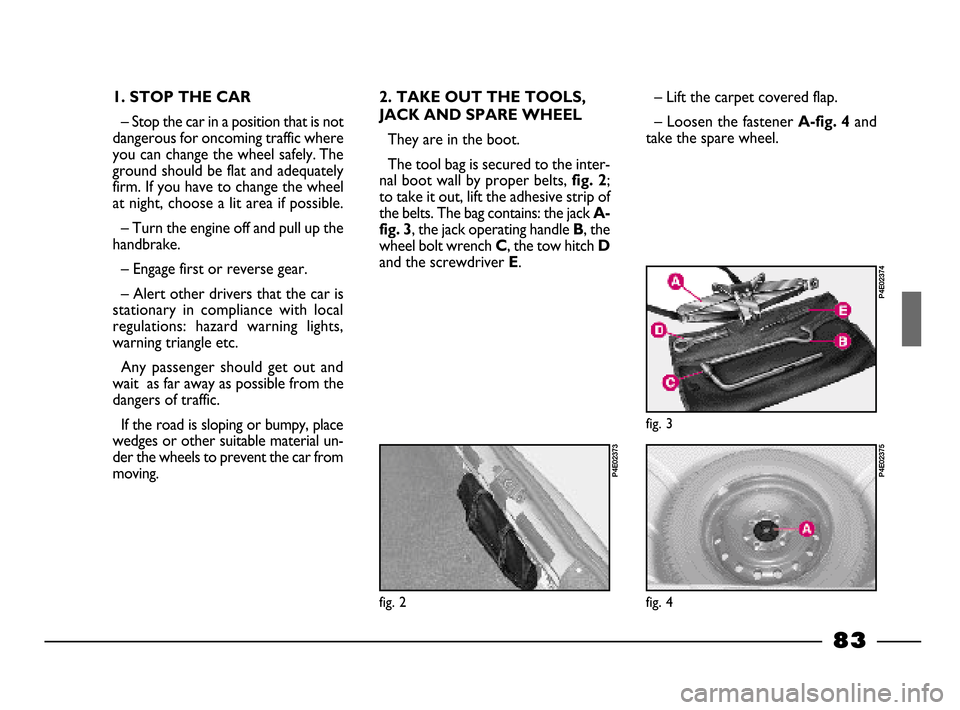
83
1. STOP THE CAR
– Stop the car in a position that is not
dangerous for oncoming traffic where
you can change the wheel safely. The
ground should be flat and adequately
firm. If you have to change the wheel
at night, choose a lit area if possible.
– Turn the engine off and pull up the
handbrake.
– Engage first or reverse gear.
– Alert other drivers that the car is
stationary in compliance with local
regulations: hazard warning lights,
warning triangle etc.
Any passenger should get out and
wait as far away as possible from the
dangers of traffic.
If the road is sloping or bumpy, place
wedges or other suitable material un-
der the wheels to prevent the car from
moving.
2. TAKE OUT THE TOOLS,
JACK AND SPARE WHEEL
They are in the boot.
The tool bag is secured to the inter-
nal boot wall by proper belts,
fig. 2;
to take it out, lift the adhesive strip of
the belts. The bag contains: the jack
A-
fig. 3
, the jack operating handle B, the
wheel bolt wrench
C, the tow hitch D
and the screwdriver E.
fig. 2
P4E02373
fig. 4
P4E02375
fig. 3
P4E02374
– Lift the carpet covered flap.
– Loosen the fastener
A-fig. 4and
take the spare wheel.
80-103 03/03/2003 06:49 PM Page 83
Page 116 of 156
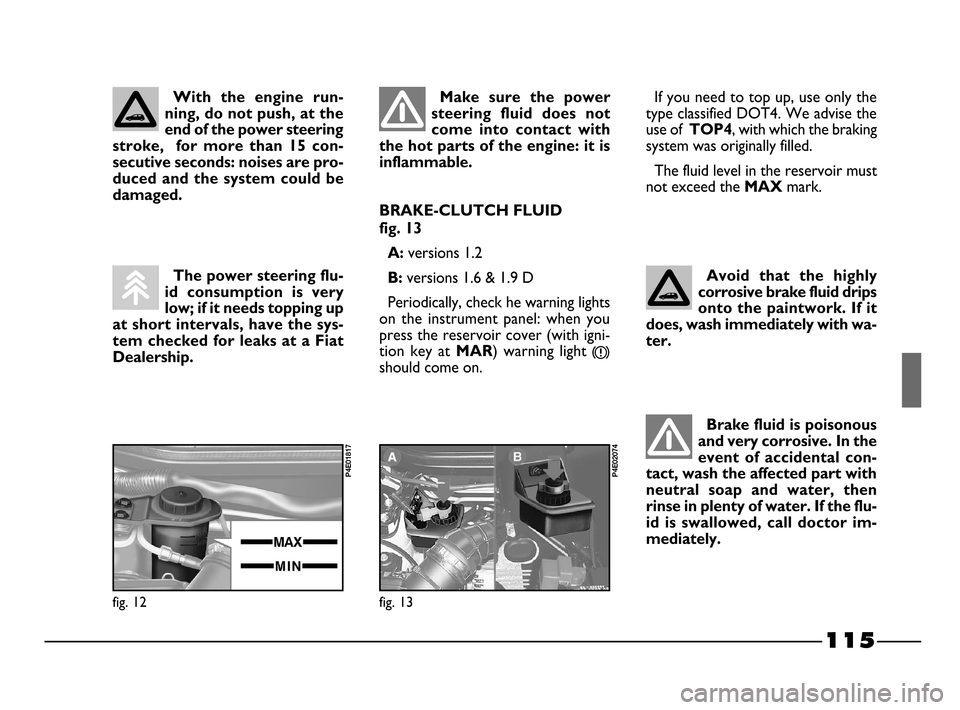
115
Avoid that the highly
corrosive brake fluid drips
onto the paintwork. If it
does, wash immediately with wa-
ter.
fig. 13
P4E02074
With the engine run-
ning, do not push, at the
end of the power steering
stroke, for more than 15 con-
secutive seconds: noises are pro-
duced and the system could be
damaged.
The power steering flu-
id consumption is very
low; if it needs topping up
at short intervals, have the sys-
tem checked for leaks at a Fiat
Dealership.Make sure the power
steering fluid does not
come into contact with
the hot parts of the engine: it is
inflammable.
BRAKE-CLUTCH FLUID
fig. 13
A:
versions 1.2
B: versions 1.6 & 1.9 D
Periodically, check he warning lights
on the instrument panel: when you
press the reservoir cover (with igni-
tion key at
MAR) warning light
x
should come on.
Brake fluid is poisonous
and very corrosive. In the
event of accidental con-
tact, wash the affected part with
neutral soap and water, then
rinse in plenty of water. If the flu-
id is swallowed, call doctor im-
mediately.
If you need to top up, use only the
type classified DOT4. We advise the
use of
TOP4, with which the braking
system was originally filled.
The fluid level in the reservoir must
not exceed the
MAX mark.
fig. 12
P4E01817
104-127 03/03/2003 06:53 PM Page 115
Page 147 of 156
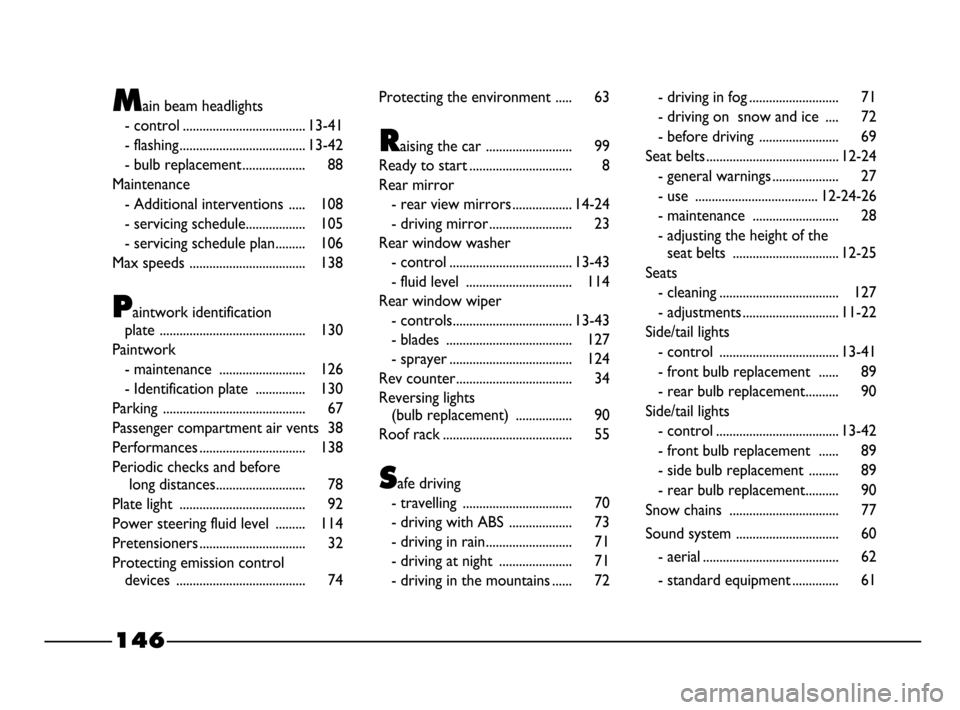
146
Main beam headlights
- control ..................................... 13-41
- flashing...................................... 13-42
- bulb replacement ................... 88
Maintenance
- Additional interventions ..... 108
- servicing schedule.................. 105
- servicing schedule plan......... 106
Max speeds ................................... 138
Paintwork identification
plate ............................................ 130
Paintwork
- maintenance .......................... 126
- Identification plate ............... 130
Parking ........................................... 67
Passenger compartment air vents 38
Performances ................................ 138
Periodic checks and before
long distances........................... 78
Plate light ...................................... 92
Power steering fluid level ......... 114
Pretensioners ................................ 32
Protecting emission control
devices ....................................... 74Protecting the environment ..... 63
Raising the car .......................... 99
Ready to start ............................... 8
Rear mirror
- rear view mirrors .................. 14-24
- driving mirror ......................... 23
Rear window washer
- control ..................................... 13-43
- fluid level ................................ 114
Rear window wiper
- controls.................................... 13-43
- blades ...................................... 127
- sprayer ..................................... 124
Rev counter................................... 34
Reversing lights
(bulb replacement) ................. 90
Roof rack ....................................... 55
Safe driving
- travelling ................................. 70
- driving with ABS ................... 73
- driving in rain.......................... 71
- driving at night ...................... 71
- driving in the mountains ...... 72- driving in fog ........................... 71
- driving on snow and ice .... 72
- before driving ........................ 69
Seat belts ........................................ 12-24
- general warnings .................... 27
- use ..................................... 12-24-26
- maintenance .......................... 28
- adjusting the height of the
seat belts ................................ 12-25
Seats
- cleaning .................................... 127
- adjustments ............................. 11-22
Side/tail lights
- control .................................... 13-41
- front bulb replacement ...... 89
- rear bulb replacement.......... 90
Side/tail lights
- control ..................................... 13-42
- front bulb replacement ...... 89
- side bulb replacement ......... 89
- rear bulb replacement.......... 90
Snow chains ................................. 77
Sound system ............................... 60
- aerial ......................................... 62
- standard equipment .............. 61
144-152 03/03/2003 07:30 PM Page 146